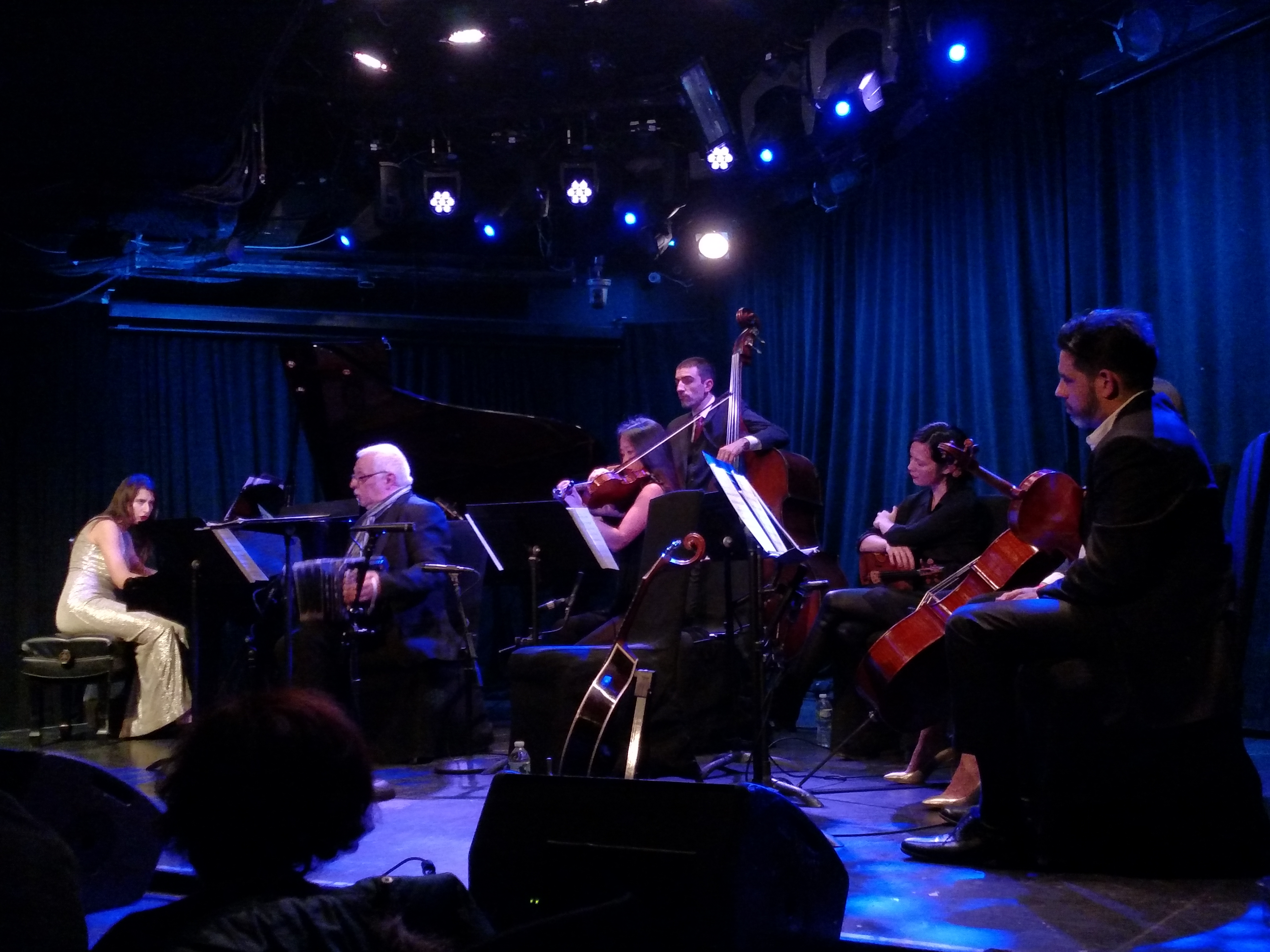Manhattan Camerata will deliver again, this time with flowers, THE TANGO FADO PROJECT to (le) poisson rouge for, albeit a day late (on Presidents Day), a “Valentine’s Concert.” This is not a gimmick: the heart of the camerata is, in its own words, “a couple in love who were invited to participate by another couple in love.” That means Daniel Binelli, bandoneonist, and Polly Ferman, pianist, as the invited, and Lucia Caruso, pianist, and Pedro H. da Silva, Portuguese guitarist, as the inviters, respectively from Argentina, Uruguay, Argentina, and Portugal, and composers and arrangers as well as players. I have never thought them less than brilliant; love, I suppose, conquers, especially as, in this project, two of the great song forms of the world, tango and fado, make a match as well.
Tango and fado have a natural rapport. It’s more than that they are each the “blues” of their own country. That’s evident enough given that neither, to my mind, much resembles the blues itself, although each has to do with with loss, longing, lament, and return, with people and places missed and gone back to. Tango has its Gardel and fado its Amália, and each an iconic port: Buenos Aires or Lisboa. There’s an overlap, if less than might be expected, in their fan base. And they have, as good matches do, their differences. Fado is more exclusively sung than tango, without a comparable tradition of large orchestras and a style of dance. Fado emerged sooner than tango, probably around 1830, and still sounds older; tango was, for a time, an emblem of modernity, both scandalous and fashionable.
So for all the similarities, arranging the match is not so easy. To go from tango orchestra to a fadista is to partake of something similar, but putting them on a stage at the same time, or adjacent on a recording, doesn’t automatically work. An artist in one isn’t assured of success in the other. Excursions into tango by Portuguese fadistas like Christina Branco haven’t persuaded me, although the theatrically astute Karina Beorlegui of Argentina finds in tangos and fados the acts and scenes of a Dickensian drama. THE TANGO FADO PROJECT, too, succeeds, and on a grander scale, uniting them as music, as though coming, after a long exploration, to the place of their birth in the spheres.
The CD of the project was presented in November at (le) poisson rouge. It starts with the high instrumental drama of the fado “Mas Importante Que Amar,” which tumbles to the end, avalanche like, atop the vocals of Portuguese-American fadista Nathalie Pires. It is driven by the most convincing use of the piano as a fado instrument, with Caruso on the pedals and keys, that I have heard. The collection shifts to what seems at first a lighthearted romp, only to devolve, once again, to drama: “Abril en Portugal” arranged as tango by Binelli for an orquesta tipica. Then comes the boldest of the camerata’s maneuvers: Gardel’s “Mi Buenos Aires querido” reconceived as the fado “Minha Lisboa Querida.” I cannot say that, for me, the experiment escapes the eccentricity of its conception, but am told by one savvier than I in Portuguese that the lyrics are unusually well transposed.
Turnabout being fair play, there’s a tango arrangement by da Silva of the Portuguese “Lisboa Antigua” as “Viejo Buenos Aires,” and, to right any remaining imbalances, a thorough tango-fado, “Cansaço,” that slides like a skater on ice from one to the other, the weariness all in the song, none in the music. “Tanguito Cordobés” is a tango, nominally, by Caruso, but was inspired, formally and emotively, by Wagner and Bach. The final track is of Piazzolla’s “Suite Troileana,” in honor of the great bandoneonista and orchestra leader Anibal Troilo, in a version complex, varied and stirring, the homage of one master to another transmigrated to their heirs.
Tango and fado are just the main romance. The project is polyamorous, pulling in African and Near Eastern musicks, and their underlying philosophies, in arrangements that find the spaces of complementarity between forms. “1=3=7” is less a mathematical provocation than a unity of religious traditions and musical scales, based on a Spanish song with Qu’ranic lyrics. “Non-Absolutist Universal Anthem” is a Bossa Nova-Flamenco-Jazz-Latin Ritmo inflected paean to Jainist metaphysics.
At the heart of the project, and perhaps (not having clocked it) halfway through the CD, is “Amor é Fogo” (“Love is Fire”), written on Valentine’s Day 2013 by Couple #1, Caruso and da Silva. Whatever its musical influences, it is neither a tango nor a fado. Pires’ lilting vocals and Caruso’s keystrokes converge in a sonnet-lullaby of romantic love, going from tender spark to effulgent flame. February 15 will mark three years and a day since its composition.
Manhattan Camerata has the shape, discipline and integrity of a classical ensemble. The sound it produces, live or recorded, is luxuriant: Caruso’s intensity on the piano, so commanding as to leave an imprint; Ferman’s lighter touch, classical and reflective; the plunge and ascent of da Silva’s fingers on the guitar; the gasp, bellow and slow complaint of Binelli on the bandoneón. Pires is at her best with them, and a backing orchestra of violin, viola, cello, doublebass, clarinet and percussion add something effusive to the sound. Listening to the CD, one is most aware of the richness of the whole. Live, the musicians add the auras of their presence: the robust Caruso, the scholarly da Silva, the elegant Ferman, the earthy Binelli. Da Silva made an agreeable host in November, his discourses amiable and lightly informative. (le) poussin rouge is ideally scaled for the camerata, with a bohemian ambiance that suits the arranged marriage of tango and fado at which they will officiate.
For information on (le) poisson rouge, click here. Visit Manhattan Camerata for more on the ensemble; click here for the CD.
